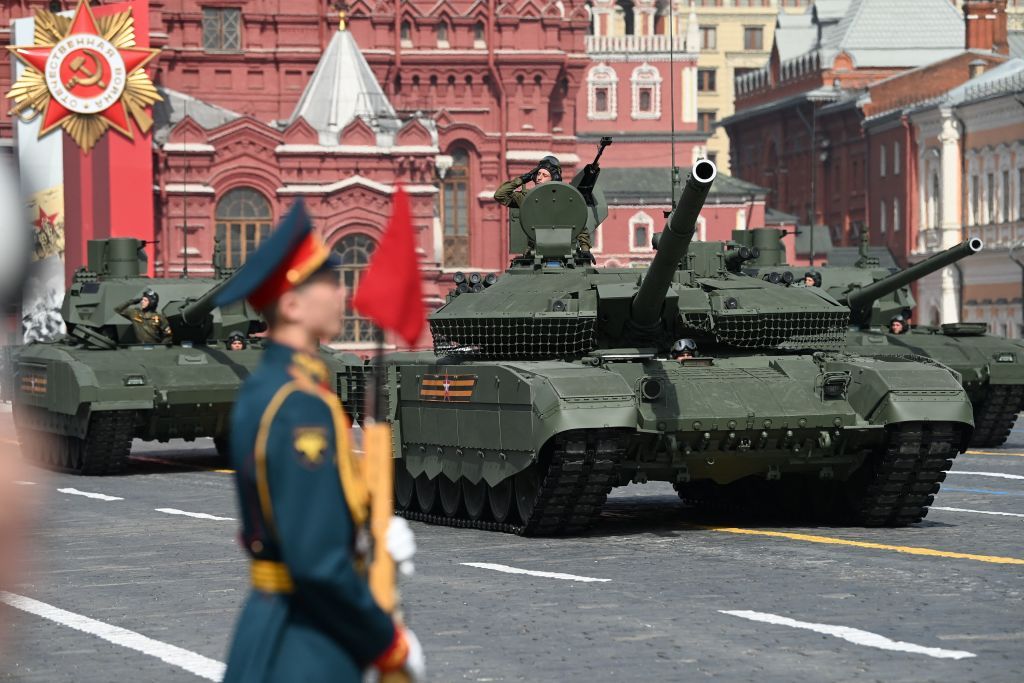At a small exhibit at the National History Museum in Kyiv on Ukraine’s flag, one notices something particular about the flags from the Soviet times and early days of independence: they’re homemade — sewn by hand with different fabrics of slightly different blues and yellows, the result of a ban on their production and display in the USSR.
A more recent flag in the exhibit is stained with blood – that of a protestor gunned down by security forces during Ukraine’s EuroMaidan Revolution in 2014. The title card beside the flag says it was draped over his body following his murder.
In the wake of Russia’s brutal invasion in February 2022, Ukrainian flags have been raised the world over from government buildings to people’s homes–even seen waving over small towns in the United States where there is no Ukrainian diaspora.
These flags serve as reminders that Ukraine’s blue-and-yellow flag is not just a national marker, but a rallying symbol of resistance, particularly one against Russian aggression, a centuries-long fight for Ukrainians.
While the blue-and-yellow bands of Ukraine’s flag have been the official state flag since Ukraine declared independence from the Soviet Union in 1991, the colors have been observed in flags and banners all the way back to the times of Rus.
If the two colors have been banned publicly during various periods of history, they have managed to find their way back out at times of Ukrainian national revival, and finally following independence.

Why blue and yellow?
It is commonly said that the blue band in the Ukrainian flag represents the blue skies above Ukraine’s bountiful fields of wheat – represented by the yellow band.
While most people seem to have settled on this logic behind the choice of colors, there is no saying exactly why they were selected, as flags and banners with blue and yellow have been recorded on Ukrainian lands going back to the 13th century.
When founding the city of Lviv in 1256, Danylo of Galicia (also known as Danylo Halytskyi), the leader of a powerful inheritor state to Kyivan Rus, made the city’s coat of arms a yellow lion against a blue background.

The Zaporizhzhian Cossacks, a powerful military and political force composed originally of serfs that existed between the 15th and 18th centuries, also used a blue background with yellow crosses, stars, and other weapons on their banners. In a painting by Ilyia Repin titled “The Reply of the Zaporozhian Cossacks” from 1891, a blue-and-yellow pole, as well as a red-and-black one, appear behind the Cossack warriors.
During a wave of European revolutions in 1848, often referred to as the “Spring of Nations,” Ukrainians in western Ukraine who were part of a 19th-century Ukrainian national revival used a combination of blue and yellow as their unifying marker.

Once again, following the Russian Revolution in 1917, the Ukrainian People's Republic, a short-lived independent Ukrainian state that lasted from 1917 to 1921, adopted the blue and-yellow-flag as seen today. It was the first time the flag as such appeared publicly at the state level.
The next time the Ukrainian flag would appear at the state level was on Aug. 24, 1991 when following the failed putsch in Moscow, a group of Ukrainian lawmakers marched a massive blue and yellow flag through the session hall of the Verkhovna Rada, Ukraine’s parliament.
The choice of a blue-and-yellow flag following independence seemed obvious, but was not without a fight. After the Declaration of Independence was adopted on Aug. 24, 1991, a month passed before Ukraine’s deputies in parliament could reach an agreement over the flag.

After two failed votes, then-Speaker of the Parliament Leonid Kravchuk (Ukraine’s first president), threatened to resign if lawmakers couldn’t vote on declaring the blue-and-yellow flag as Ukraine’s national flag. Over the course of the month, the red Ukrainian SSR flag remained above the Verkhovna Rada.
Kravchuk’s threats worked, and the national blue-and-yellow flag was raised over the dome of the Verkhovna Rada next to the flag of the Ukrainian SSR. The two flags side by side caused outrage. Kravchuk ordered the red and blue Soviet flag to be lowered, and the flag of an independent Ukrainian state fluttered alone over the Verkhovna Rada for the first time on Sept. 4, 1991, where it has been ever since.
Why do we see a black and red flag in Ukraine sometimes?
Among the Ukrainian blue-and-yellow flags in Ukraine, there is sometimes a flag with a red banner over a black one seen hanging from people’s windows, at rallies, and on the battlefield. For some in Ukraine, these colors also represent the fight against oppression.
Ukraine’s detractors allege the flag is that of Ukrainian “neo-Nazis,” owing to the fact that it was the flag of the Ukrainian Insurgent Army, known by the acronym of its Ukrainian name UPA, founded by the Organization of Ukrainian Nationalists, or OUN.
When the Nazis invaded the Soviet Union in June 1941, some members of the OUN, and later the UPA, cooperated with the Nazis. The Nazis eventually turned on the OUN, arresting and imprisoning the OUN-B’s leader Stepan Bandera. By 1942, the Nazi Germans and the OUN were fighting each other.

In the West, the OUN and UPA are perhaps most notoriously known for the murder and displacement of thousands, particularly ethnic Poles who were living in what is now western Ukraine.
During the Volyn tragedy, in a region in northeastern Ukraine, the OUN murdered thousands of Poles between 1943 and 1944. While most of the victims were ethnic Poles, Ukrainian civilians were also killed by Poles in retaliation.
Jars Balan, head of the Ukrainian Canadian Studies Center at the University of Alberta in Edmonton, has said that the red-and-black flag colors represent Ukrainian nationalism that long pre-dates WWII, with the two colors appearing in Slavic songs as old as the 12th century.
"The people who are waving them are the people who identify with the tradition of militant Ukrainian nationalism. They respect the fact that the OUN and UPA took up arms in the struggle for Ukrainian independence," Balan told CBC News.
"They realized this was not going to be achieved in a ballot box in a dictatorship, and they would have to fight for their independence. And so, in adopting the red and black flag, they really are identifying themselves with that tradition."
Today, the red-and-black flag is often seen alongside the blue-and-yellow state flag on military checkpoints and in liberated cities and towns.

Symbol not only of resistance but of pride
One flag at the National History Museum had been rescued from Russian occupation where Russian troops had been using it as a rag to wipe their feet in a prisoner of war camp back in 2014, when Russia first invaded Ukraine, occupying parts of its eastern Donetsk and Luhansk oblasts and annexed Crimea.
In another similar case from Russia’s full-scale invasion, Ukraine’s Foreign Affairs Ministry published a video of a woman digging up a Ukrainian flag in Kherson following the city’s liberation from Russian occupation in November 2022.
While the Ukrainian flag appears most prominently in moments of Ukrainian resistance to oppression or an aggressive neighbor, the flag has also been present at moments throughout history during which Ukrainians have made milestones around the world.

Following independence, scientist Valeriy Petrushchak along with Nataliia Makedon made a round-the-world trip in their sail boat in the mid 1990s. The trip, which covered 30,000 miles, three oceans, and 12 seas, was the first round-the-world trip for a citizen of independent Ukraine. Eighteen different countries saw the Ukrainian flag waiving from the ship.
Ukrainian climbers have raised the flag on Mount Everest, the flag went on a space shuttle discovery mission, and has been raised above the Akademik Vernadskyi Antarctic station. It also traveled around Europe with pop-singer Jamala following her Eurovision Contest win in 2016.
And in one proud, albeit bittersweet moment, for Ukrainians, a Ukrainian flag traveled all the way from the battlefield in Bakhmut to the U.S. Congress in December 2022 and was held up by Vice President Kamala Harris and Speaker of the U.S. House of Representatives Nancy Pelosi as President Volodymyr Zelensky received a standing ovation.












